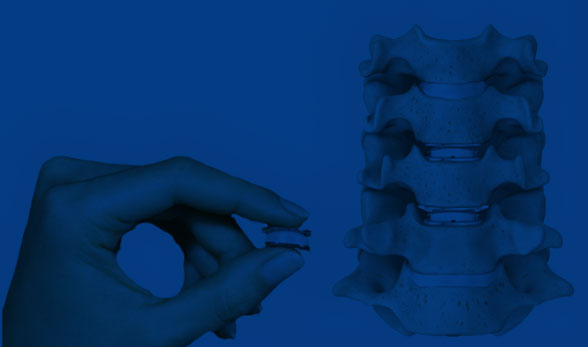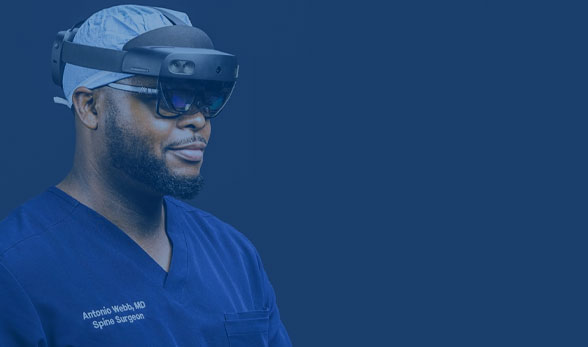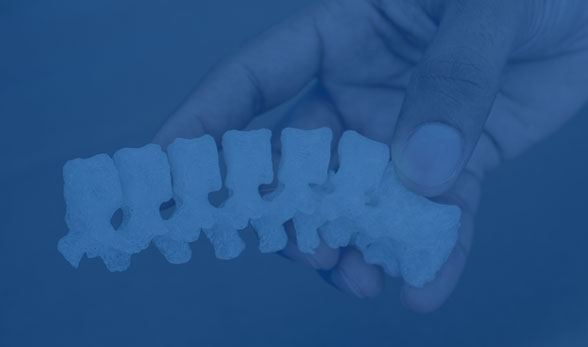Artificial Disc Replacement
Cervical = area of your neck at the top of your spine
Disc = intervertebral disc that is compressing on your spinal cord/nerves in the neck
Replacement = replacing diseased/degenerated disc material with a metal or plastic cage.
A cervical disc replacement, also called artificial disc replacement (ADR), is a procedure that removes your degenerated disc and replaces this area with a biomechanical device that is designed to maintain/preserve mobility in your neck. This is similar to a hip or knee replacement which are designed to restore natural joint mobility.
Why do a cervical disc replacement vs a fusion?
There are many advantages of doing a disc replacement rather than a fusion of your neck.
- Maintain your neck motion: a fusion operation fuses the bones in your neck, causing you to lose motion in that area of your spine. Alternatively, a disc replacement helps you to maintain your motion.
- Lowers the chance that you will need additional spine surgery in the future: when spinal segments are fused, there is a chance that the loss of motion in the fused segment adds stress on the levels above or below the fusion, which may cause those levels to break down faster. A disc replacement allows you to maintain your motion, thus decreasing the chance that the levels above and below this site break down.
- Quicker recovery : a fusion operation fuses the bones in your neck which can take anywhere from 8-12+ weeks whereas in a disc replacement, there are no bones that need to fuse together meaning you can return to activities and the things you love to do sooner.
Who is a good candidate for a cervical disc replacement?
Generally, patients who are younger, have good bone quality, minimal arthritis, more arm pain than neck pain, and soft disc herniations are good candidates for this procedure. Dr. Webb can discuss whether you are a good candidate for this procedure at your visit.
Approach
The surgery is done by making a small incision on either the right side or left side of your neck. This will be decided by Dr. Webb and discussed with you at your visit. Doing the surgery by going through the front of your neck has many advantages over doing a surgery from the back (posterior) of your neck including:
- Lower infection risk vs going through the back of your neck.
- Generally, a quick surgery and shorter recovery than going through the back of your neck.
- Less blood loss
- Less postoperative pain
- Less muscle damage: muscles are not cut, they are moved to the side and allowed to fall back in place when surgery is done.
The Procedure
Anesthesia & Induction
- Your anesthesiologist will talk to you about the specifics of his/her plan for the procedure. You will find out what medications and what type of anesthesia will be used to keep you pain free and comfortable throughout the operation.
- In general, most patients will undergo general anesthesia during spine procedures meaning you will be asleep and wont remember or feel any pain during the procedure itself. Patients may have pain upon waking up from anesthesia, but this will be managed with intravenous and oral pain medications.
- After a breathing tube is placed and you are fully asleep, you will be positioned on the operating room table.
- Surgery will not begin until you are asleep and given pain medications so that you don’t feel any pain during the procedure.
- A skin incision is made on the left or right hand side of the anterior neck (depending on surgeon preference). After dissecting through the skin, Dr. Webb will find the space between your esophagus and trachea (windpipe). He will carefully move these out of the way. In between these two structures lies your spine.
- No muscles are cut, they are just moved to the side and held apart with the use of special tools, called retractors.
Performing the Decompression
- Before removing the diseased disc, Dr. Webb will confirm that he is operating at the correct level by taking an x-ray while you are asleep.
- When the level is confirmed, Dr. Webb will then begin the decompression (removing the areas of compression from your spinal cord) portion of the procedure.
- Dr. Webb will then carefully remove the disc that is pressing on your spinal cord/nerves with the use of special instruments and tools.
- With the diseased disc removed, any additional surrounding structures which may be pressing on your spinal cord, such as bone spurs and/or excess ligaments, will be removed.
- Dr. Webb will then ensure that your spinal cord and nerves are free from compression.
Performing the Disc Replacement
- After the spinal cord has been decompressed and all the diseased disc material removed, this area/void needs to be replaced with something.
- This area will now be replaced a metal artificial device, called an artificial disc.
- The artificial disc will indirectly decompress your spinal cord and nerves by “jacking open” your disc space.
- This is similar to “jacking up” and changing your tires on your car after a flat tire. When your car is “jacked up”, there is more room for the tire to be placed and also relieves pressure off of the tire. Similarly, in spine surgery when a metal or plastic cage is placed in between your bones, this “jacks up” the space that houses your spinal cord and nerves, giving them more room.
Closure
- The retractors that held the area between your trachea and esophagus apart will now be removed and the trachea/esophagus will be allowed to fall back into their normal position.
- Dr. Webb uses absorbable sutures to close your wound. These sutures do not typically need to be removed and will absorb on their own.
- Sometimes, a special tube called a drain will be used. This is to collect any blood or fluids that can collect after surgery. This drain will be removed before you leave the hospital, usually the next day after surgery.
Frequently Asked Questions
What can I expect after surgery?
After surgery you will be transferred to the recovery room, also called the PACU (post anesthesia care unit). After you have awaken from the anesthesia, you will then be transferred to your hospital room. This is typically when your family members can visit you.
Either the same day or the following morning after surgery, a physical and/or occupational therapist will begin your therapy. During your hospital stay, you will be given medications to help with pain and IV antibiotics to minimize the risk of infection. Most patients spend 1-2 nights in the hospital and are discharged home after:
- You are tolerating a diet
- Your pain is controlled
- After you have worked with and passed physical therapy.
Walking after surgery is highly encouraged, even the same day of surgery!
What kind of recovery can I expect after surgery?
Recovery from a cervical artificial disc replacement surgery takes 8-12 weeks, but patients continue to heal for up to a year after surgery.
When can I return to work and/or activities?
Walking is highly encouraged, immediately after surgery and throughout your post operative period. Most patients can return to a light desk job or household activities by 2-3 weeks after surgery. Patients with jobs that require heavy lifting or strenuous labor will not be allowed to return until Dr. Webb ensures your implant is stable and growing into the bones solidly. In addition, activities such as biking, skiing, or running will not be allowed until Dr. Webb ensures your implants have grown into place.
When will my neck or arm pain go away?
If you can imagine putting your elbow on a hard surface for a long time, what happens? Your fingers start to go to sleep. Why? Because the nerves to these fingers is compressed, is asleep, and is irritable. Once you realize this, you pick up your elbow (to remove the pressure off the nerve) and shake your fingers until they wake up.This is a similar concept in spine surgery where depending on how long your nerves and spinal cord have been compressed, will determine how long it takes for the nerve to wake up after the surgery. If you have had compression of your nerves and spinal cord for months to years, then it may take some time before the nerve recovers and wakes up (if it recovers at all). Most patients, however wake up from surgery with arm pain relief meaning that the debilitating arm pain they had before surgery has went away, but may have some neck pain and spasms from the surgical incision itself. This pain will be controlled with oral/IV pain medications and antispasm medications throughout your hospital stay.
What complications should I be aware of?
Inadequate relief of symptoms
- Dr. Webb is very particular about making sure we target the right level of your spine that may be causing your symptoms.
- Inadequate relief of symptoms after surgery could be due to a number of things including: multiple levels that are degenerated or worn out that will not be addressed in surgery, surgery done on the wrong level, or advanced and severe spinal cord compression that may be irreversible.
- Injections are confirmatory and are very predictive of how well you will do with surgery. These spinal injections, usually done before surgery in the conservative treatment period, are essential in determining which level of your spine is the cause of your symptoms.
- Just because you have multiple degenerated areas of your spine according to your imaging studies (MRI, X-ray, etc.), does not mean every level needs an operation.
Nerve damage, causing speech or swallowing issues
- There are small nerves that control your larynx (voice box) that reside very close to the surgical site.
- Dr. Webb carefully works around these nerves and ensures they are not damaged during surgery.
- If they become irritated by surgery, your voice may be hoarse for weeks to months after surgery until the nerve recovers.
- Some patients may also have a sore throat from the endotracheal (breathing tube) placed during surgery or from the retraction of the esophagus and windpipe during surgery. This tends to get better after surgery.
Dural tear
- The dura is the outer layer of the spinal cord. Sometimes, this layer can be especially thin in certain patients and very friable. During surgery, if there is a small tear in this layer, Dr. Webb will attempt to repair it. This is a not a very common complication, but definitely one that needs to be known.
- Sometimes after a dural tear is repaired, Dr. Webb may ask that you sit upright for 24 hours after surgery. This is done to give the repair time to heal and to ensure his repair does not come apart.
- Fortunately, multiple studies have shown that having a dural tear repair does not affect your outcome from surgery.
Infection
- Very low risk (<1%) but this risk is increased if you are overweight, immunosuppressed, on chronic steroids, or diabetic.
- Antibiotics will be given before surgery starts and also given for 24 hours after surgery while you are in the hospital to decrease the risk of infection.
Bleeding
- Very low risk, but increased if you are taking blood thinners, fish oil, herbal medications or have a clotting disorder.
- These medications will need to be stopped before surgery.
- Sometimes, a special tube called a drain will be placed during surgery. This tube is to collect any blood or fluids that can collect after surgery. This drain will be removed before you leave the hospital, usually the next day after surgery.
Spinal cord or Nerve damage
- Very low risk
- A neuromonitoring technician is a professional trained in the monitoring of your nerves and spinal cord.
- This person (along with a Neurologist) is part of the team that will be taking care of you during surgery and will help Dr. Webb monitor your nerves and spinal cord throughout the procedure.
- You will be able to meet this person the morning of surgery and ask any questions about their role in your care.
- Generally, after you are asleep from anesthesia, this technician will place small wires on your legs and arms so that the nerves and spinal cord and be monitored during surgery.




